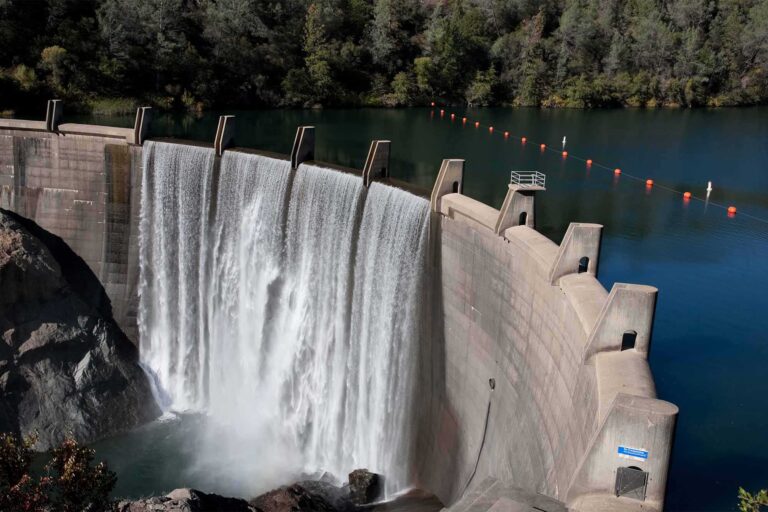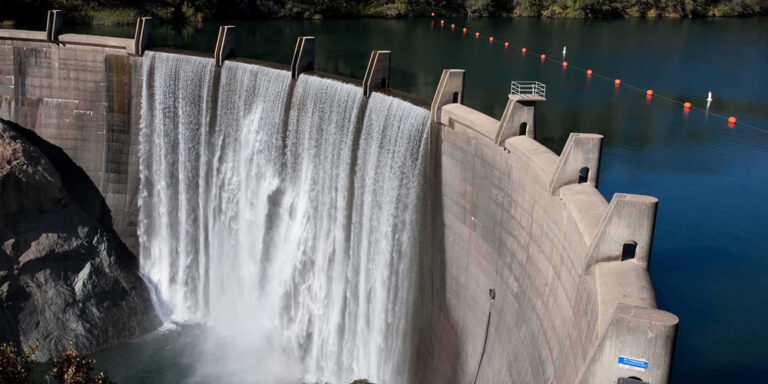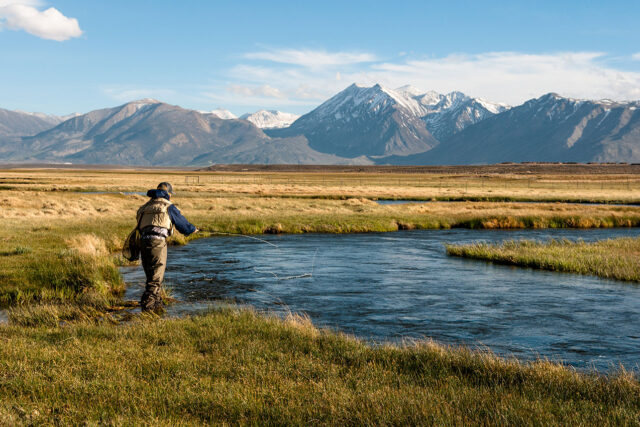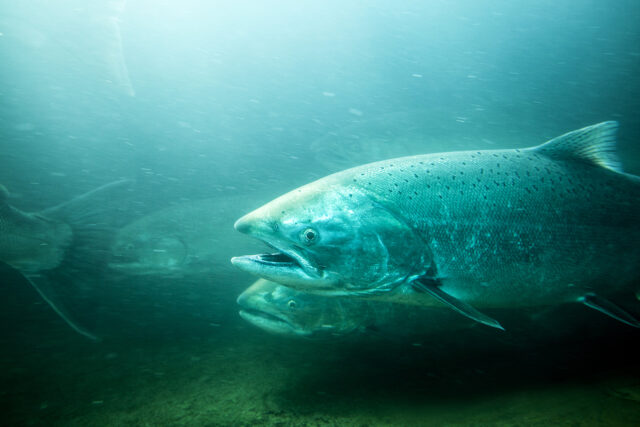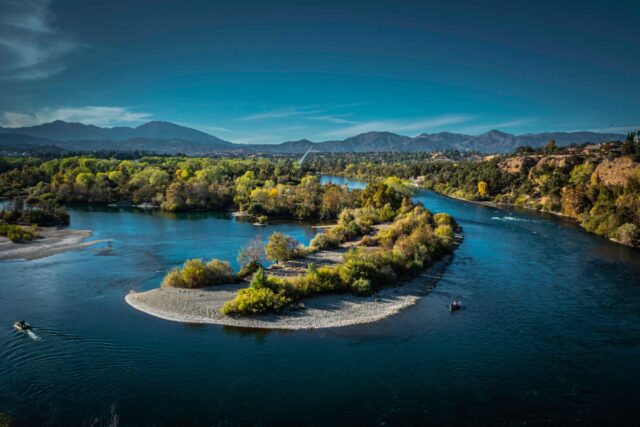Table of Contents
- Key Takeaways
- Introduction
- The Paradox of Managing Water Storage for the Environment
- Managing Reservoir Storage for the Environment
- Creating and Managing the Environmental Water Budget
- Conclusion
- Notes and References
- Authors and Acknowledgments
- PPIC Board of Directors
- PPIC Water Policy Center Advisory Council
- Copyright
Key Takeaways
Large reservoirs like those that rim the Central Valley are essential for managing water in California’s highly variable climate. They provide multiple benefits including water supply, hydropower, flood management, and recreation. However, construction and operation of these reservoirs have also imposed significant environmental costs, including native fishes’ loss of access to high-quality habitat above dams and degradation of freshwater ecosystems below them. Moreover, regulatory uncertainty for water users is rising as these ecosystems decline. California needs a new approach for managing environmental water in its large reservoirs, particularly as the climate warms and droughts become more intense.
- Constraint-based environmental regulations make it difficult to improve river health below dams. Too often, the environment is treated as a constraint on reservoir operations, rather than as a management objective. This leads to narrowly defined—and inflexible—flow and water quality standards that focus on a few listed species of fish. This also promotes a “manage-to-the-edge” approach that increases risk to the environment when forecasting or operational errors occur. Making ecosystem health a primary objective of reservoir operations would enable better overall management of hydrologic uncertainty and ecological risks. →
- Reserving storage space in reservoirs for the environment—along with a share of inflow—is a better approach. Modeling shows that it is possible to meet environmental needs efficiently when storage space is allocated to the environment along with a portion of inflow to the reservoir. This combination creates an ecosystem water budget that can be flexibly managed, with timing of releases varied to create the most environmental benefit. Although ecosystem water budgets can reduce water available for some users, this approach can also benefit other users by reducing regulatory uncertainty. →
- Robust governance structures are needed to manage water stored for the environment. Although various approaches are possible, the best way to administer the environmental water budget is through a designated trustee who has the authority to allocate the water, prepare annual plans for its use, evaluate performance, and coordinate with a range of parties including downstream restoration managers, reservoir operators, water users, and regulators. →
- Funding for ecosystem water in reservoirs is key. Water and storage assets for the environment can be expanded through regulation, negotiation, purchase, and new water infrastructure investments. A combination of water user and state support could fund the costs of creating and managing ecosystem water budgets. →
- Many ongoing regulatory and planning efforts would benefit from setting aside reservoir storage space as part of an ecosystem water budget. Efforts are underway to update the Bay-Delta water quality control plan, negotiate voluntary agreements to implement the plan, update water supply operations to meet endangered species requirements, set new criteria for environmental flows, and fund new water storage and environmental water acquisitions. All of these efforts could use water allocated to the environment more efficiently if they incorporated storage space for environmental water. →
Further Reading
For more information, please see the technical appendices that underpin this research:
“Technical Appendix A: California’s Freshwater Fishes: Conservation Status, Impacts of Dams, and Vulnerability to Climate Change” by Peter Moyle, Anna Sturrock, and Jeffrey Mount
“Technical Appendix B: An Experimental Reservoir Model for Storage and Allocation of an Ecosystem Water Budget” by Sarah Null, Harrison “HB” Zeff, and Anna Sturrock
“Technical Appendix C: Proposition 1 Water Storage Investment Program” by Gokce Sencan and Jeffrey Mount
“Technical Appendix D: Legal Issues” by Brian Gray and Barton “Buzz” Thompson
Introduction
California’s freshwater ecosystems—its lakes, rivers, floodplains, meadows, natural and managed wetlands, and estuaries—are a vital part of the state’s natural infrastructure. These ecosystems provide numerous benefits, including water supply, hydropower, flood control, fisheries, recreation, and cultural and aesthetic value. They are also home to the nation’s most diverse array of plant and animal communities, with numerous freshwater species found only in California (Jensen et al. 1993; Grantham et al. 2017).
But this vital natural infrastructure—and the biodiversity that relies upon it—is in decline. Water and land use practices, pollution, the proliferation of non-native species, and fisheries management all contribute to the decline—as does the construction and operation of surface storage. In addition, ongoing changes in the climate—including warming and increasing drought intensity—are further stressing river ecosystems and making management more challenging.
Managing water in California’s highly variable climate relies heavily on the ability to store water, both in surface reservoirs and underground. Without this storage, the state could not meet its water supply needs, especially during frequent droughts. This begs an important question: can this vital storage—which has contributed to the decline in freshwater ecosystems—be managed differently to support and revive the health of rivers?
This report is one in a series by PPIC that identifies ways to improve freshwater ecosystem management in California. We examine how current approaches to reservoir management fail to protect ecosystem health and lead to, or exacerbate, conflicts. We identify alternative approaches, including creation of ecosystem water budgets; assignment of storage space for environmental management; and flexible, integrated management of environmental flow releases and other habitat improvements. We use a simplified reservoir water balance and temperature model to illustrate how setting aside a portion of reservoir inflow along with storage space can protect downstream ecosystems more efficiently than environmental water without storage. We also propose governance structures that could implement this novel approach, ways to create the water and storage assets of an ecosystem water budget, and ways to fund these programs. We conclude with suggestions about how this approach can be incorporated into five ongoing regulatory and planning efforts involving reservoirs in the Central Valley (Box 1).
This report benefitted from the input of a broad array of experts and interests. Through a series of workshops and interviews we met with federal, state, and local reservoir operators; representatives of Central Valley water users; state and federal regulatory and planning agencies; environmental nonprofits; and the program managers for the seven Proposition 1 Water Supply and Infrastructure Program projects.
A suite of technical appendices provides more details on aspects of our analysis, including an assessment of dams’ impacts on native fishes (Appendix A), modeling scenarios for environmental water flows and storage (Appendix B), state storage investments under Proposition 1’s Water Storage Investment Program (Appendix C), and legal considerations for allocating and managing water storage for the environment (Appendix D).
Box 1: This report informs numerous ongoing regulatory and planning efforts
Large, multi-purpose Central Valley reservoirs dominate water supply, flood control, hydropower, and ecosystem management in the Bay–Delta and the greater Sacramento and San Joaquin River watershed. Five interrelated regulatory and planning efforts are underway that affect how these reservoirs will be operated to protect downstream riverine, estuarine, and wetland ecosystems. The analyses and recommendations of this report inform these efforts, including:
- California Environmental Flows Framework (CEFF). This is a collaborative, multi-agency, multi-stakeholder effort to establish environmental flow criteria throughout the state (Stein 2021). Its centerpiece is identifying functional flows (components of a river’s flow that sustain the biological, chemical, and physical processes on which native species depend) for all rivers. As this report shows, on rivers with large, multi-purpose dams, storage is needed to meet functional flow criteria.
- Bay–Delta Water Quality Control Plan Update (Bay–Delta Plan Update). The State Water Resources Control Board (State Water Board) is setting new flow standards for the Bay–Delta system to meet updated biological objectives. The first phase of this effort focuses on the Lower San Joaquin River and its tributaries. A 2018 State Water Board order requires that from February through June a percentage of unimpaired inflow be bypassed from reservoirs and released into the rivers. This report shows that flexible use of reservoir storage would help meet the flow objectives more efficiently. This approach can also be incorporated into ongoing Federal Energy Regulatory Commission relicensing efforts on Lower San Joaquin River tributaries.
- Voluntary Agreements (VAs). The California Natural Resources Agency and both export and in-basin users of water from the Sacramento–San Joaquin Delta watershed have been negotiating agreements that seek to meet the biological objectives of the Bay–Delta Plan Update. Current agreements include the provision of additional water for the environment through reductions in use (principally on farms) along with investments in physical habitat. The agreements are vague on where this water will come from and how it will be stored and allocated. This report identifies how storage of this water can be managed to meet biological objectives—and recommends governance and funding systems that could support the effort.
- Coordinated Long-Term Operations of the Central Valley Project (CVP) and State Water Project (SWP). In 2021 the US Bureau of Reclamation (USBR, which operates the CVP) and the California Department of Water Resources (DWR, which operates the SWP) began discussions with state and federal fish and wildlife agencies over operations of the two projects that affect species protected by the state and federal endangered species acts. These efforts will involve reoperation of project reservoirs; they present an opportunity for a new approach to storing water for the environment, such as that outlined in this report.
- State investments in environmental water and storage. California will invest more than $2.7 billion in seven new surface and groundwater storage projects using state bond funds from Proposition 1 (2014). The state is funding public benefits from these projects, including new water for the environment (see Appendix C for details). This bond also allocated $200 million to environmental water purchases, and additional resources for water acquisitions have been included in recent state budgets (Hanak and Sencan 2022). Setting aside storage space for the environment would improve the management of this new environmental water.
The Paradox of Managing Water Storage for the Environment
Reservoirs are California’s most important tool for water management. The roughly 40 million acre-feet (maf) of available storage in more than 1,500 reservoirs allows California to generate hydropower, reduce flood risk, and manage supply during seasonal dry periods and frequent, multi-year droughts. This storage is, in turn, connected to a statewide grid that includes underground storage in aquifers and a conveyance network to meet demands throughout California (Escriva-Bou et al. 2019). Without this water grid, California could not support its vibrant economy and population of nearly 40 million residents.
Despite these benefits, the construction and operation of reservoirs in California are major contributors to the decline in condition of many of the state’s rivers (Grantham et al. 2014). The state’s water management system adversely affects all plant and animal communities that rely on rivers. This is best illustrated by its impacts on the conservation status of fishes. For example, of the 122 species of native freshwater fish found in California today, more than 80 percent are in decline and at risk of extinction within this century, and more than one-quarter are at critical risk of extinction in the near future without accelerated conservation actions (Figure 1). More than half of the at-risk species are also significantly impacted by dams and their operations (for details see Appendix A).
Most of California’s freshwater fishes face extinction, many because of dams
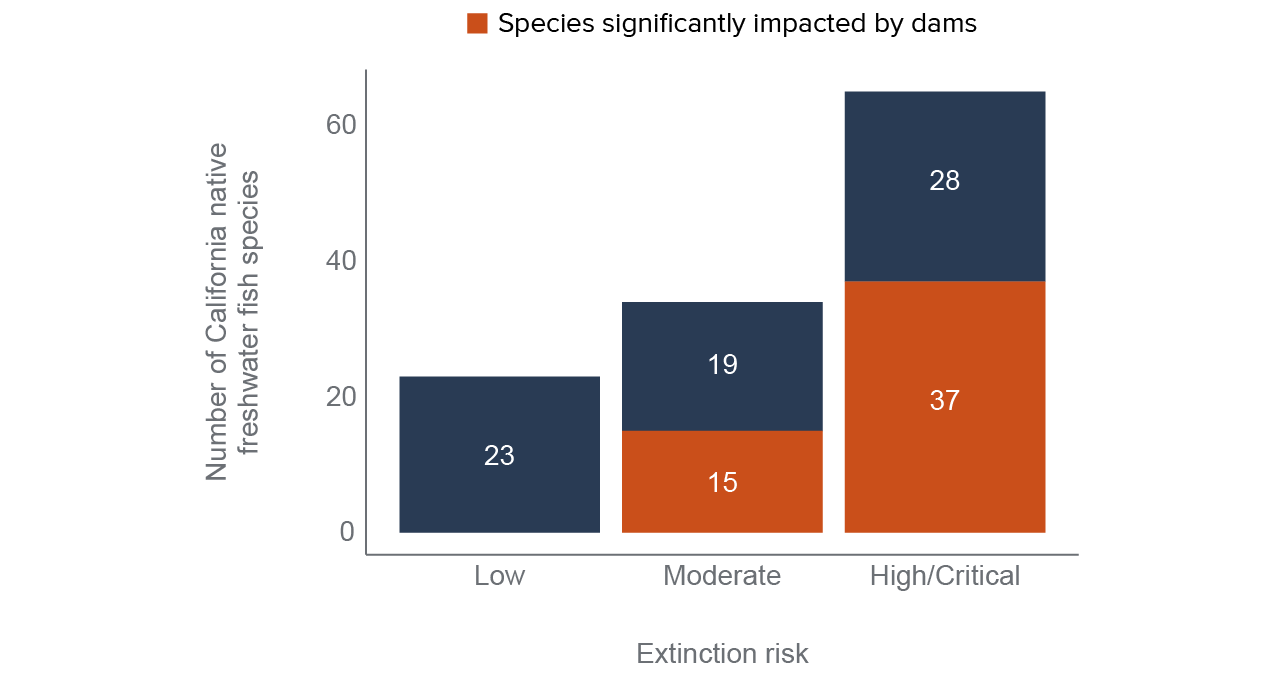
SOURCE: See Appendix A.
NOTES: Bars depict the number of native California fish species in categories of concern over the risk of extinction during the 21st century, of a total of 122 species. Fishes ranked as low risk are abundant and widespread. Moderate risk fishes are in decline. High and critical risk fishes have experienced substantial reductions in abundance and range and are at serious risk of extinction in the wild. The number of species in each conservation category that are moderately to critically impacted by dam construction and operation are depicted in orange.
The construction and operation of dams have contributed to the decline of California’s riverine fish and wildlife. Although dam removal addresses this problem most effectively (e.g., Carmel River, Klamath River), this is practical for only a handful of the state’s large dams. Instead, and paradoxically, California will need to rely for the indefinite future on dams—albeit operated differently—to conserve species and restore ecosystem health. This paradox is illustrated well by the plight of salmon and steelhead. Dams have cut off access to their headwater spawning and rearing habitat (Figure 2), concentrating these fish in poor-quality downstream habitat (Hanak et al. 2011). Reservoir operations—including changes in flow timing, temperature, and volume—further contributed to the decline in habitat quality and salmon survival (Sturrock et al. 2020). Flow and water quality changes are compounded by the introduction and invasion of non-native predators (San Francisco Estuary Institute 2014) and the loss of riverine habitat associated with changes in land use.
But the major contributor to the decline of these and other native fishes—dams and their reservoirs—also holds the key to their survival. This is particularly true for cold-water dependent fishes that are no longer able to access their historic habitat (Box 2). Efforts are underway to consider moving salmon above major dams, allowing them access to historic spawning grounds. Yet these programs have technical challenges that will need to be addressed. For the foreseeable future, conservation efforts will rely on changes in reservoir operations—along with efforts to improve physical habitat downstream and manage other stressors—to improve freshwater ecosystems.
Dams have disconnected headwaters for salmon and steelhead throughout California
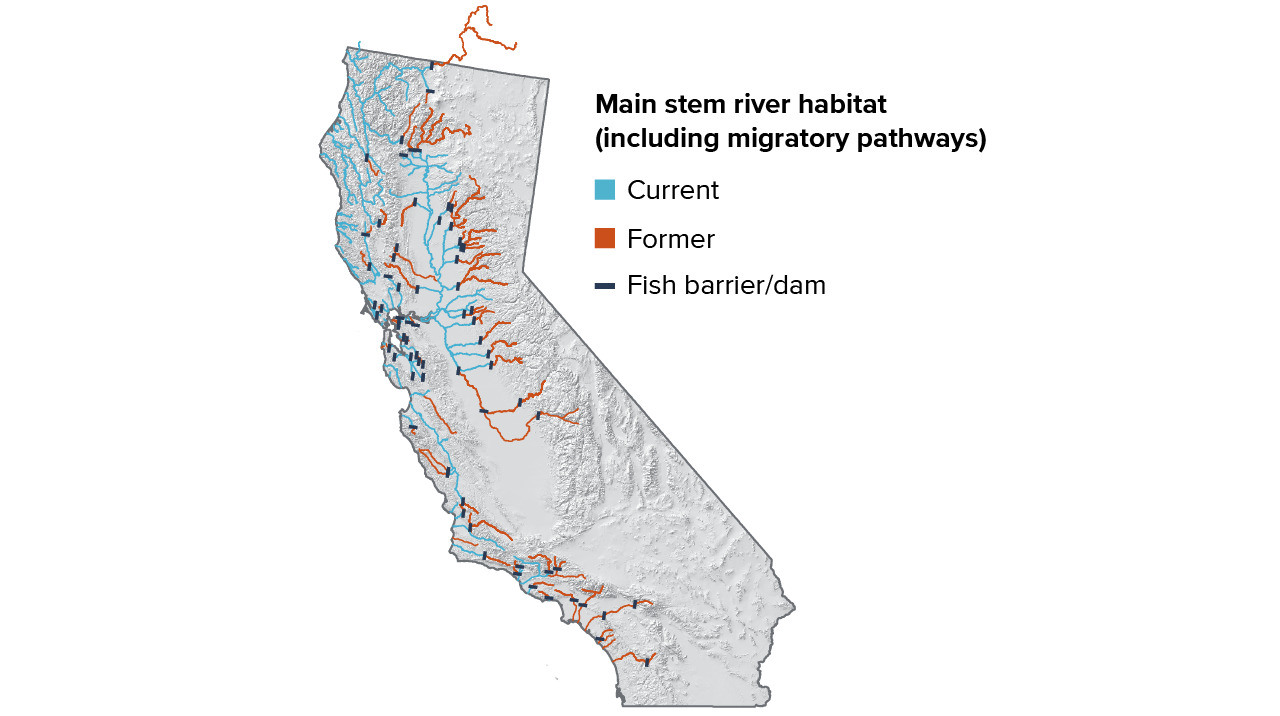
SOURCE: From Hanak et al. (2011).
NOTE: The segments of rivers depicted in red are blocked to access by steelhead and salmon that historically made use of headwaters for spawning and rearing.
Box 2: The challenge of managing water temperatures for salmon
When completed in 1945, Shasta Dam cut off headwater access to all salmon and steelhead in California’s largest river system. Sacramento River winter-run Chinook salmon relied on cold, spring-fed rivers like the McCloud, a tributary to the Sacramento, for spawning and rearing habitat. Today these fish—which are close to extinction in the wild and listed as endangered under the federal Endangered Species Act—depend upon managed releases of cold water drawn from deep in Shasta Reservoir to maintain headwater-like ecosystems.
During 2021, the US Bureau of Reclamation (USBR) was unable to meet temperature standards below Shasta Dam, and warm water releases contributed to the loss of almost 98 percent of eggs and fry (Null et al. 2021). The events of 2021 highlight the challenges of managing downstream temperatures, particularly as droughts become more intense in California’s warming climate.
Many factors affect the temperature of water released from reservoirs, but the key to management is the volume of the “cold-water pool” and the ability to tap into that water as the reservoir is drained for hydropower and water supply over the spring and summer.
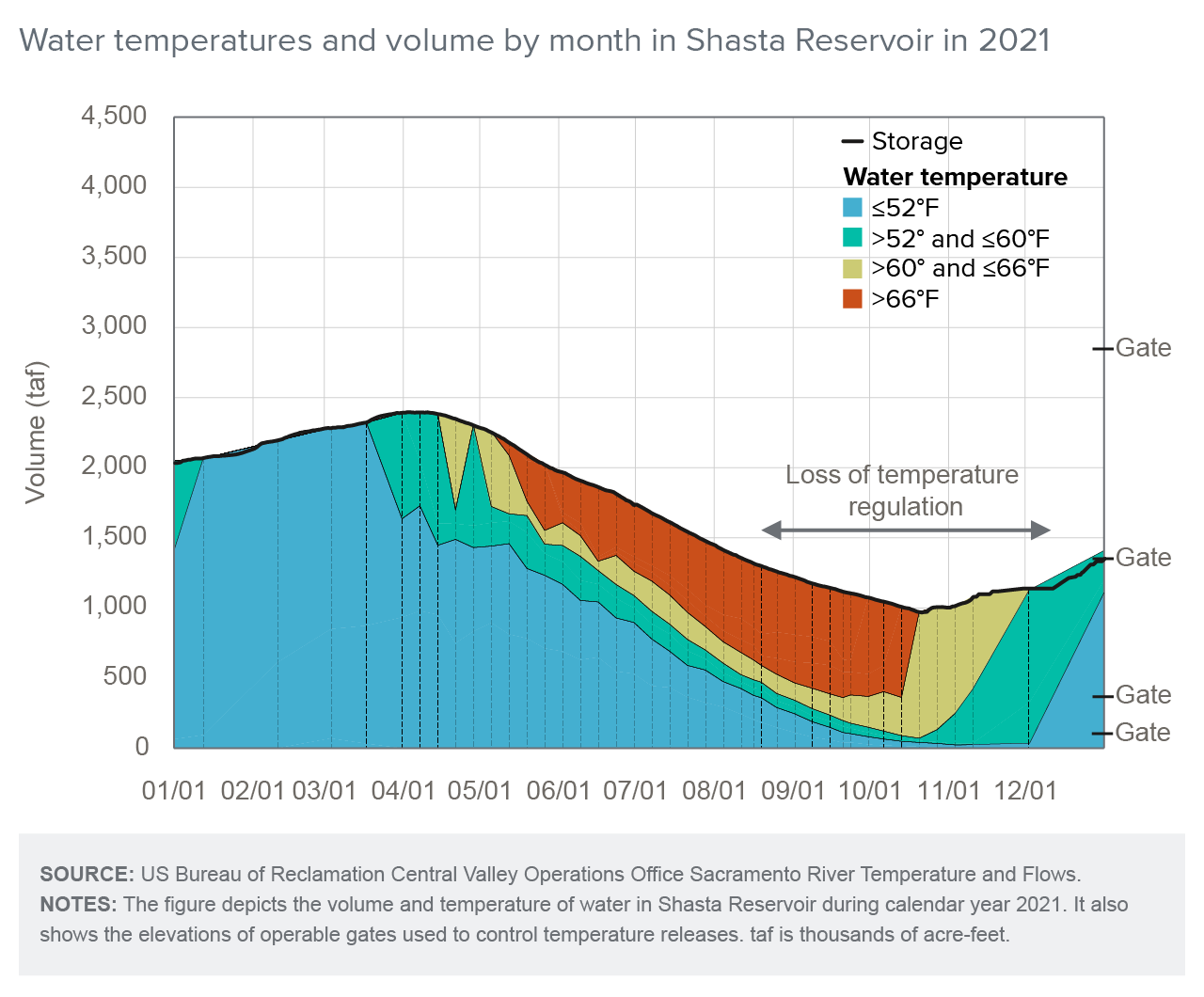
The figure above depicts both the temperature and volume of water in Shasta Reservoir during 2021, along with the levels of temperature control gates that allow reservoir managers to blend water from different depths. This blending attempts to provide optimal release temperatures and to conserve the cold-water pool as the reservoir is drawn down over the summer.
In 2021, predicted snowmelt runoff failed to materialize, limiting not just the volume of the cold-water pool but also its overall temperature. By mid-April, waters at the surface of the reservoir began to warm rapidly due to increasing air temperatures and the high angle of the sun. This process—called stratification—happens every year in large reservoirs. Over the summer this warm surface layer deepens, steadily reducing the cold-water pool. The cold-water pool also declines as releases of water for supply, hydropower, and cold water for downstream habitat tap into it.
By late August of 2021, the cold-water pool was depleted and operators could only draw water from their deepest gate. When this occurs—as it does in most years in the fall—release temperatures steadily increase. In 2021, the early loss of control over water temperatures and warm-water releases during late summer contributed to extensive losses of winter-run Chinook eggs and fry (NOAA n.d.).
The paradox of surface storage also extends to wetlands management. The construction of dams supported the conversion of floodplain wetlands to other land uses throughout the Central Valley. Surface storage became the primary source of water supply to managed wetlands, which are essential for mitigating the loss of habitat, including for millions of birds that migrate along the Pacific Flyway. Nineteen federal, state, and private wetland complexes rely heavily on federal reservoirs to meet their annual water needs (Box 4, below).
Finally, storage is critical for adapting to the changing climate for all water users, including the environment. Climate warming will reduce the amount of water stored in snowpack—an important source of cold water for many native species. Additional changes include a lengthening of the dry season, increasing volatility of precipitation across years, and rising sea levels and saltwater intrusion into the Delta and other estuaries (Mount et al. 2018). Warming is also increasing evaporative demand—or the thirst of the atmosphere—as well as the water requirements of crops and other vegetation (Albano et al. 2022). These pressures are already altering the hydrologic cycle in California and are anticipated to intensify throughout this century (Ficklin et al. 2022; Swain et al. 2018). They will make it more difficult to manage storage to improve conditions of rivers and wetlands, and further increase the vulnerability to extinction of many freshwater species (Appendix A).
The Environment as a Constraint
Although managing reservoir storage differently is key to improving ecosystem health and adapting to changing conditions, the rigidity of existing regulatory strategies makes this difficult. This stems partly from the current treatment of environmental water as a constraint on project operations, rather than as a primary objective of multi-benefit water management.
To our knowledge, none of the more than 1,500 dams in the state were constructed specifically to improve freshwater ecosystem conditions. Instead, reservoirs were built with one or more operational objectives—water supply, hydropower generation, and flood management—with recreation often identified as an ancillary benefit. For most dams—particularly those in the Central Valley—environmental management requirements were added later in response to declines in native species. Environmental regulations—usually in the form of prescribed minimum instream flow and water quality standards—restrict reservoir operations to reduce harm to downstream water quality, fish and wildlife, recreation, and other instream uses. In this way, the environment functions as a constraint—a regulatory obligation that must be met as a precondition to pursue project objectives.
This constraint-based approach has the potential to allocate water for the environment in inefficient ways. As described in previous PPIC publications, the use of minimum flow and water quality standards—commonly set to meet endangered species acts requirements—has been ineffective, failing to reverse the decline in freshwater ecosystems and native biodiversity (Mount et al. 2017; Grantham et al. 2020). Multiple, increasingly prescriptive flow and water quality regulations create rigidities and limit the ability of reservoir operators, environmental managers, and regulators to respond in a timely way to hydrologic events (ranging from individual storms to major floods and droughts), changing climatic conditions, and new information. Inflexible environmental regulations also make it difficult to conduct experiments to support adaptive management, which are widely recognized as necessary to improve freshwater ecosystems (Newson 2008). Finally, the capacity of regulatory agencies to change course on regulations is limited, making it difficult to adapt constraints to changing conditions. For example, the Bay–Delta Plan (Box 1)—currently being updated—is more than 25 years old.
An example of this challenge comes from the Central Valley Project (CVP) and the State Water Project (SWP). Project operations are constrained by a complex, and sometimes contradictory, set of regulatory standards adopted under the state and federal water quality and endangered species acts. Many of these standards focus narrowly on protecting specific life history stages of listed fish species (e.g., temperature standards for salmon eggs and fry, Box 2). As discussed in Mount et al. (2019), this narrowly defined, constraint-based approach to environmental regulation has multiple problems, including inadequate water to meet ecological objectives and insufficient flexibility to adapt in ways that improve overall ecosystem condition. It also encourages a “manage to the edge” mentality that seeks to maximize water supply, hydropower generation, and flood control priorities while leaving little room for error.
And unfortunately, errors in reservoir forecasting and operations are increasingly common, with significant environmental consequences. For example, in 2014, 2015, and 2021—all severe drought years—monitoring, modeling, and forecasting at Shasta Reservoir indicated that spring releases of water for farms and cities could be accommodated while still meeting downstream environmental constraints. In each of these years, technical errors were discovered during or after the spring releases, leaving insufficient water in the reservoir to meet environmental standards. This harmed ecosystems that are critical for winter-run Chinook salmon (Box 2) and ultimately led to requests to relax environmental standards. If the environment had been a primary objective during these years—rather than a constraint—project operators likely would have been more cautious in their decision making and may have avoided some of the environmental harm caused by these errors.
California needs a new approach to the way it manages its large, multi-purpose reservoirs—one that shifts away from viewing the environment as merely a constraint and instead sets protection and improvement of ecosystem health as a primary objective. In the following section we evaluate alternative approaches to reservoir management and show how creating assets for the environment can help achieve this shift.
Managing Reservoir Storage for the Environment
Earlier PPIC reports have examined ways to improve ecosystem conditions while minimizing impacts on water supplies for other users. These reports explain why it is necessary to shift from the existing reliance on minimum flow and water quality standards to protect ecosystems (the constraint-based approach) and toward ecosystem-based management, including investment in physical habitat paired with functional flow releases (Grantham et al. 2020). This new approach focuses on overall ecosystem condition—rather than life stages of individual species—and integrates water management into other efforts to improve ecosystem health. Ecosystem-based management requires the allocation of assets to the environment—specifically an ecosystem water budget (EWB). And it is essential that this EWB be managed like a senior water right, with priority over most other water uses and greater flexibility in use, including the ability to time flows to maximize ecological benefits and store or trade water (Mount et al. 2017).
In this report we recommend making the environment an operational priority for managing rivers with large, multi-purpose reservoirs. This can be accomplished by allocating a proportion of inflow to an EWB, assigning reservoir storage space to manage the EWB, defining the priority of stored environmental water and reservoir capacity relative to other uses, and integrating the EWB storage and release schedule into reservoir operations.
Here we examine several ways to create and manage an EWB on rivers that have large reservoirs and multiple, competing demands for water. We draw insights from a simplified model of reservoir temperature and operations to examine trade-offs between storage options and different environmental and water supply objectives.
One important caveat bears noting at the outset: the purpose of this modeling analysis is to identify the important trade-offs that will need to be evaluated if EWBs are established on California’s rivers. The results are not intended to be used to set specific targets for EWBs and storage space in reservoirs. Each of California’s large reservoirs is unique—with differences in runoff, infrastructure, and environmental and supply demands—and most are operated in conjunction with other reservoirs. Further in-depth analysis will be necessary to evaluate and set actual targets for EWBs and storage space.
A Model Reservoir
The hypothetical reservoir we modeled is large—and similar to Shasta Reservoir in terms of the timing and volume of inflow, water demands, and operational constraints (see Box 3 for highlights and Appendix B for details). The model tracks existing regulatory water demands (in simplified form) and allows us to represent new functional flow demands for environmental water. It also tracks other water demands for urban and agricultural users and wildlife refuges. We used it to test various approaches to setting aside and managing an EWB.
Box 3: Model reservoir characteristics
The model reservoir—with approximately 4.5 million acre-feet (maf) total storage—has many of the characteristics and operational constraints of a large, multi-purpose Central Valley reservoir such as Shasta Reservoir (see figure). This includes:
Highly variable seasonal and interannual inflow. To simulate this, we used 26 years of recent Central Valley hydrology (1996–2021) as inflow and then ran the model on monthly time steps.
Temperature stratification and changes in cold-water pool volume. We simulated this by using a water temperature model to represent the cold-water pool (see Box 2) and to track how operations affect release temperatures (USACE–HEC 1986; Null et al. 2013).
Seasonal flood storage. From the late fall through early spring, all large Central Valley reservoirs must keep some storage space available for flood management. We simulated this by using typical operational storage and release requirements.
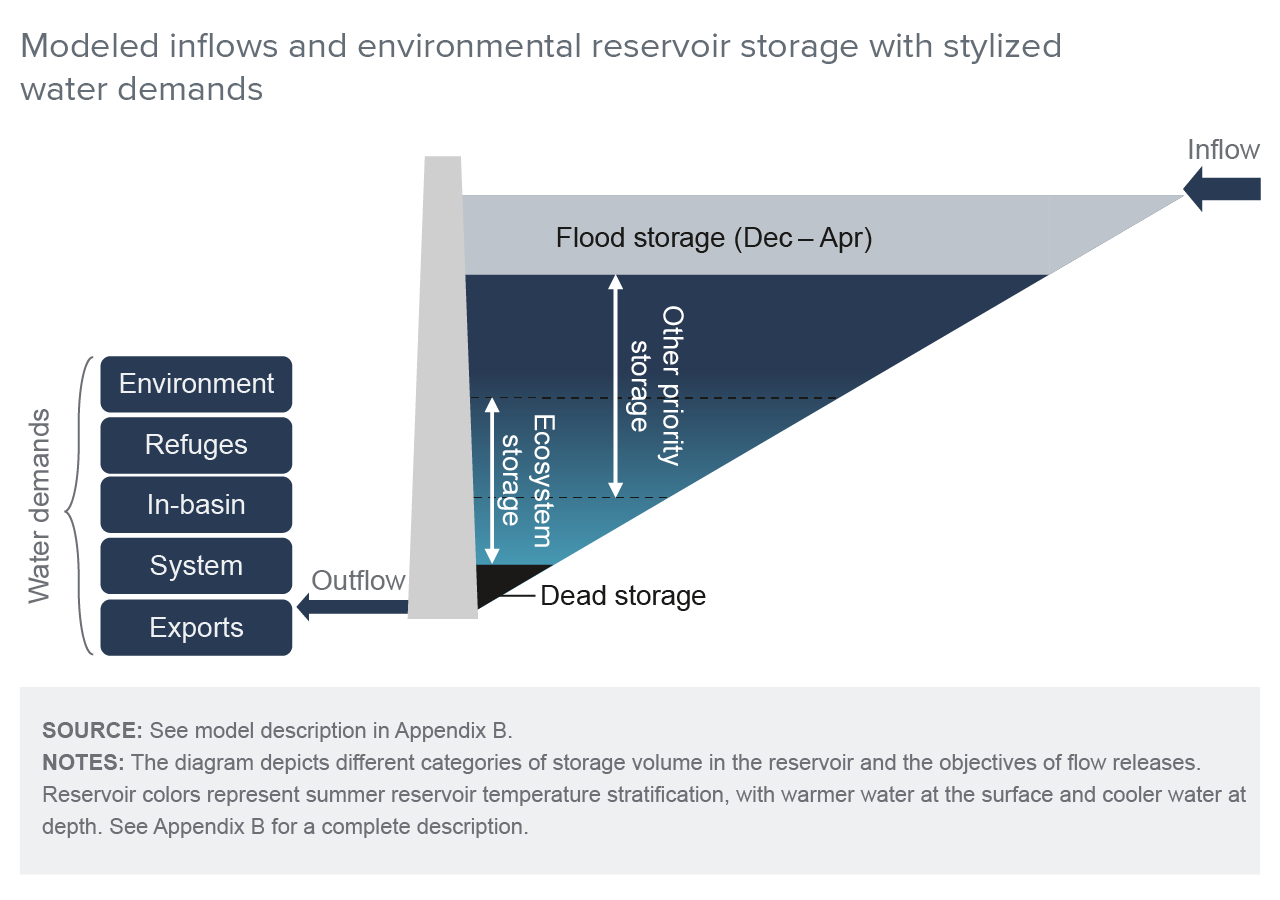
Environmental Water Budget Demands
Environmental water budget demands in the model can be adjusted for priority and amount. In our modeling alternatives, we vary the amount of water assigned to meet these demands under several types of EWB. The categories, listed in order of priority, are:
- Environmental baseflow demand. This demand supports flows typically required for instream flow and additional Delta outflow (above those required for system outflow, described above) to meet current environmental objectives and endangered species requirements (based on Gartrell et al. 2022; SJRRP 2022; SWRCB 2019). Environmental baseflows have considerable monthly variability, and they are larger in wetter years and smaller in drier years (Gartrell et al. 2022; Null and Viers 2013).
- Temperature of reservoir releases demand. This demand maintains the cold-water pool throughout summer and fall to manage downstream temperatures. We used a range of current water temperature targets for spawning and rearing habitat of multiple Chinook salmon runs to constrain cold-water pool temperature and volume from spring through fall. We organized temperature objectives into a primary objective to maintain suitable temperature for salmonids (warmer) and a secondary objective to provide optimal temperatures for salmonids (colder). The results shown here are for optimal temperatures. Both suitable and optimal temperature targets are defined in Appendix B.
- Functional flows demand. We simulated the demand for meeting three types of new functional flows in downstream river channels. Figure 3 shows how volumes set aside for functional flows could be released to meet ecosystem objectives. We based the volume of water set aside for these flows on estimated habitat requirements for multiple runs of Chinook salmon, but functional flows would have broader species benefits. In priority order they are:
- Spring recession flow demand. These flows are the most reliable in undammed rivers. They mobilize and deposit river gravels, cue migrating salmon, support recruitment of riparian vegetation, and are key to amphibian reproduction.
- Winter pulse flow demand. These flows augment winter storm events, inundating channel margin and floodplain habitat for juvenile salmon, shorebirds, and waterfowl. They also scour channels and redistribute sediment and wood.
- Fall pulse flow demand. These flows mark the end of the dry season. They clean spawning gravels, cue salmon migration, and freshen water quality.
Two additional functional flows—summer and wet season baseflows—were presumed to be met by environmental baseflow.
Conceptual illustration of how targeted releases of EWB water could be used to meet functional flow demands
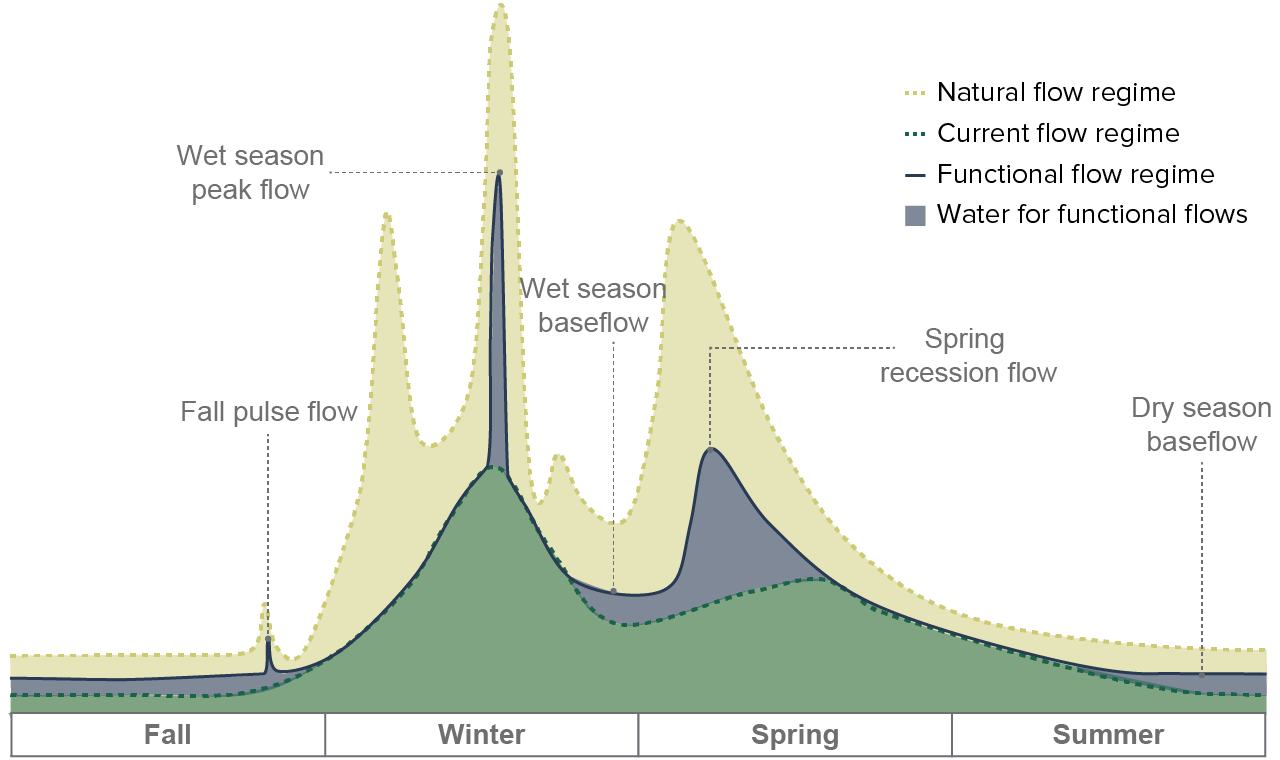
SOURCE: From Grantham et al. (2020).
NOTES: Figure illustrates a hydrograph of a river in the Central Valley that is heavily regulated by an upstream reservoir. The current managed flow regime (dashed green line) includes instream flow and water quality standards, but still has reduced flows during key periods of the year relative to the natural flow regime (dashed brown line). Releases of ecosystem water budget water for functional flows (shaded grey area) can be used to augment the current flow regime to create functional flows that improve ecosystem condition while minimizing impacts on other water uses. This makes more efficient use of water allocated to the environment.
Other Water Demands
To estimate other existing water demands (in simplified form), we surveyed large, multi-purpose reservoirs in the Central Valley—including CVP and SWP reservoirs and those managed by individual water districts. From this we developed four categories of water demand. The first three—refuge, in-basin urban and agricultural, and system water for salinity maintenance—share highest priority in the model, but demand varies depending on the time of year. The last—out-of-basin exports—is junior to the other demands.
- Refuge water demand. This is water that is diverted to meet Central Valley Project Improvement Act Level 2 managed wetland demands (Box 4 and note 6). Although refuge water supports the environment, it is separated from the EWB because under today’s CVP operations it has the equivalent of a senior water right. Although we have not explored this, the EWB could be used to augment refuge water deliveries—for instance to meet Level 4 demands.
- In-basin urban and agricultural demand. This is water for cities and farms downstream of the reservoir. For simplicity we grouped demands in this category, rather than separating them by water right priorities.
- System water for salinity maintenance. This is water used to keep the Delta fresh enough for exports and local agricultural and urban demands; it flows out of the Delta to the Bay and the ocean. Although this water also provides ecological benefits, that is not its primary function, so it is not counted as part of the EWB.
- Out-of-basin export demand. This is water exported to out-of-basin users, similar to CVP and SWP exports from the Delta. For simplicity we grouped demands in this category; they have a junior priority in the model and do not receive water until the senior demands are met.
We did not include other demands in our model—such as hydropower generation and recreation. And again, although we included water demand categories guided by existing CVP and SWP practices, the model is not intended to represent actual project operations.
Box 4: Storing water for wildlife refuges
Land reclamation over the past 150 years has destroyed or degraded more than 90 percent of California’s Central Valley wetlands (Frayer et al. 1989). The wetlands that remain continue to provide habitat to the millions of shorebirds and waterfowl migrating along the Pacific Flyway every year. Today, these migratory birds—and all wetland-dependent wildlife—are limited to a relatively small extent of intensively managed public and private wetlands, supplemented by seasonally flooded agricultural lands.
Water for managed wetlands is administered differently than water that provides ecological benefits in rivers and estuaries. Managed wetlands rely on a portfolio of water sources, including surface water rights, tailwater collected from nearby farms, groundwater pumping, and water exchanges. Water in CVP and SWP reservoirs is an important source for many managed wetlands.
Following severe declines in migratory bird populations, the 1992 Central Valley Project Improvement Act (CVPIA) required that USBR annually provide historical average water deliveries (termed “Level 2” water) to 19 critical wetland complexes and, based on estimates of water needed to fully support these wetlands (USBR 1989), required USBR to deliver the full water needs of these refuges (“Full Level 4” water) by 2002.
Level 2 water is secure—with a priority roughly equivalent to senior water rights-holders—and has only been reduced during severe drought. There has been only modest progress in meeting Level 4 water requirements, however, and total water deliveries have become more variable, with an overall declining trend associated with increasing frequency of dry years and drought severity (CVJV 2020).
In addition to managed wetlands, rice fields in the Sacramento Valley make up a large component of the wetland habitat mosaic in the Central Valley. These fields are flooded in the fall and winter after harvest, which helps decompose rice straw while also providing foraging habitat to migratory birds and in some cases outmigrating juvenile salmon. These acres provide as much as 50 percent of the food resources needed for wintering waterfowl and shorebirds in the Central Valley (CVJV 2020; Dybala et al. 2017). Yet there is concern over a declining trend in winter rice flooding due to a combination of drought and changing economic conditions—which make water supplies to managed wetlands even more critical for migratory birds.
Establishing and Allocating an Ecosystem Water Budget
We experimented with different approaches to setting, storing, and releasing an EWB and evaluated how well each scenario met demands for both the ecosystem and other water users. Our experiments fall into two general categories for comparison.
- Bypass of a percentage of inflow. In the first experiment, we allocated between 10 percent and 40 percent of inflow to the environment. The percentage of inflow that entered the reservoir was bypassed downstream. We then simulated the impacts of this approach on EWB and non-EWB demands. This experiment is analogous to the State Water Board’s new flow objectives for the Lower San Joaquin River and its tributaries. In 2018 the board adopted amendments to the Bay–Delta Plan that established these objectives based on a percentage of unimpaired flow from February through June (SWRCB 2019). This novel approach creates an EWB, principally by requiring that reservoirs bypass a prescribed portion of unimpaired inflow. It has the advantage of varying with seasonal and interannual changes in runoff into reservoirs, potentially benefiting the ecosystem by mimicking the natural flow regime (albeit at significantly lower levels and different times than historical flows). The Lower San Joaquin River unimpaired flow standard does not preclude storing water to meet the ecosystem objectives, but neither does it require doing so.
- Percentage of inflow and percentage of storage capacity. In this second experiment, we gave the EWB two assets: a proportion of inflow and storage space in the reservoir to manage it. As above, we varied inflow allocations between 10 percent and 40 percent, and we allocated storage space to manage the EWB by the same proportion. This approach is used in the Australian state of Victoria, where water for the environment has an “entitlement” equal to that of high-priority urban and farm water. A portion of storage capacity is set aside for environmental water, which an Environmental Water Holder releases to meet habitat objectives (Mount et al. 2016). As discussed in more detail below in our review of governance options, the San Joaquin River Restoration Program (SJRRP) also allocates a portion of unimpaired inflow and storage space in Millerton Reservoir for ecosystem management. An advantage of this approach is that water can be stored until it is needed for downstream ecosystems.
Cold-water pool considerations. Since temperature is both an important regulatory issue and essential to maintaining habitat for cold-water dependent fishes, we did additional model runs that also constrained minimum reservoir storage to 1.25 maf to preserve the cold-water pool.
Spillover considerations. An important challenge for modeling EWBs and storage comes during times of abundance. The release of water from a reservoir to make space for additional inflow is often referred to as “spill”—a common occurrence during winter and early spring to meet flood management objectives. From an accounting perspective it matters greatly whose water gets spilled. Water users will hold on to water that remains in reservoirs in the fall for use if the following year is dry. But if winter precipitation is high, this “carryover water” might be spilled to prevent flooding (and is no longer available). We assigned spill by priority of water demands (so exporters’ water spilled first), and then in proportion to the volume held in carryover by each senior demand.
Here we compare the performance of different sizes and types of EWBs for drier years, when trade-offs are most acute (Figure 4a–h). Appendix B provides additional results.
Performance of inflow bypass
The larger the share of inflows dedicated to bypass EWBs, the better they do at meeting environmental baseflow and functional flow objectives (Figure 4a). This is to be expected, since large bypass flows come closer to mimicking natural flow conditions and variability. Smaller bypassed EWBs routinely fail to meet these demands. But the bypass approach generally presents a trade-off with another key environmental objective: regulating downstream temperatures. Higher bypass shares erode the cold-water pool in drier years, greatly reducing the number of months when temperature standards are met. Retaining a minimum of 1.25 maf of stored water to protect the cold-water pool helps, but only slightly. This is because total reservoir storage is consistently lower when 10 percent to 40 percent of inflows are bypassed through the reservoir for the EWB (Figure 4c). Sometimes more water is bypassed than is needed to meet EWB flow demands.
Figures 4e and 4g show the corresponding impacts on other water demands. As expected, larger EWBs lead to greater shortages for other water users. Yet the impact of a bypass EWB appears modest for all but the export demands. The large impact on exports—with less than 60 percent of demands met with a high EWB—results from their junior priority in the model. All other water demands also lose some reliability when minimum storage reserves are held back to protect cold water (Figure 4g).
Performance of inflow plus storage space
An EWB that combines a portion of inflow with reservoir storage space generally does a better job of meeting environmental objectives than bypass flow alone (Figures 4b and 4d). This is because storage space enables the EWB water to be used more efficiently. In our model reservoir, nearly all environmental baseflows and functional flows are delivered when about 30 percent of inflows and reservoir storage are allocated to the EWB. In addition, water temperature demands are better met in dry years—both with and without a minimum level of storage held back to protect the cold-water pool. The ability to store EWB water for when it is needed also has a side benefit for temperature management, because it generally raises reservoir storage.
As with the bypass EWB, this approach has impacts on water to meet other demands (Figures 4f and 4h). Setting aside large EWBs and storage space poses considerable trade-offs with export demands, which are most junior in our model. Relative to the bypass EWB, this approach also increases shortages somewhat for other, higher-priority uses, which have less storage to rely on for meeting their needs. And as above, reserving 1.25 maf of storage for the cold-water pool increases the trade-offs between meeting environmental and other water demands.
Dry-year performance of bypass and inflow-plus-storage options for an EWB
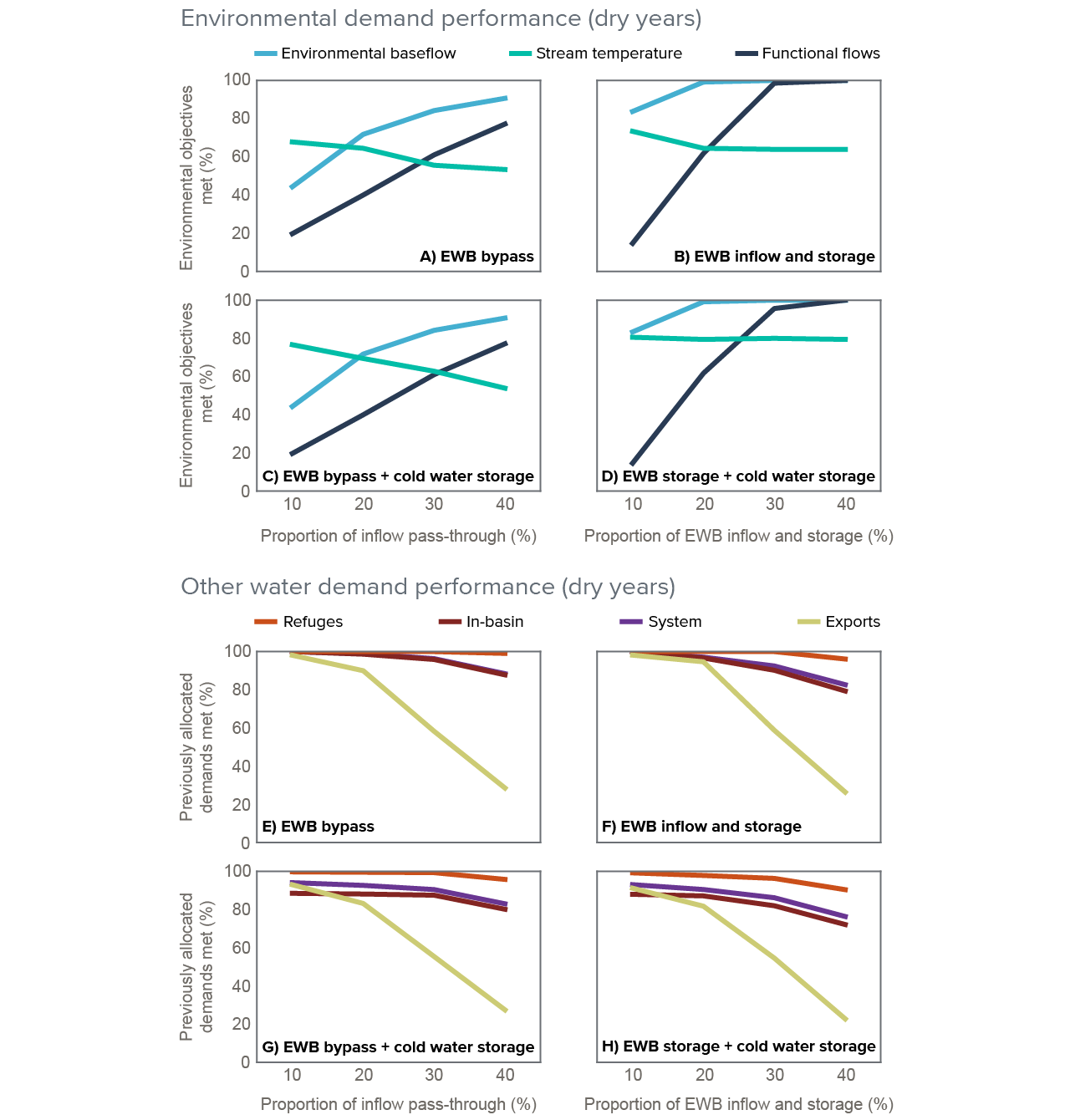
SOURCE: Appendix B.
NOTES: The figures show average performance for different types and levels of EWBs in below-normal, dry, and critically dry years across 26 years of hydrologic conditions. Panels a–d show the percentage of times when environmental objectives are met and panels e–h show the percentage of water deliveries to meet other water demands. Scenarios include an EWB with bypass flows (a share of inflows and no storage) (a and e), an EWB with a share of inflows-plus-storage (b and f), and these two scenarios with a minimum of 1.25 maf of cold water storage (c and g for bypass, and d and h for inflows-plus-storage, respectively).
Key takeaways from the reservoir model
Our simplified reservoir model highlights the kind of trade-offs that would occur between meeting environmental and other water demands when setting aside an environmental water budget. The key takeaways include:
- Relying exclusively on the bypass of reservoir inflow (without storage) is a less efficient way to meet environmental objectives. The higher the percentage of inflow bypass, the better the performance for functional flows, but in most years performance falls well short of demands due to the inability to store the EWB. Higher bypass flows also increase risk to meeting downstream temperature needs by eroding the cold-water pool. Reservoir storage minima or other temperature management strategies must be established to meet temperature demand.
- Setting a combined EWB—with both a portion of inflow and a portion of storage space to manage it—is a more efficient way to meet environmental water demands. But to meet downstream temperature needs, it may also be necessary to set minimum storage levels to help preserve the cold-water pool.
- Establishing an EWB has costs for water users, and particularly junior water rights-holders. The bypass option has fewer impacts on non-EWB demands because no storage space is used to manage the EWB. Setting a minimum reservoir level to protect cold water impacts water availability for all other demands.
As we noted above, while these simulations provide insights, they should not be used to establish a percentage of inflow or storage space to manage it. Sophisticated reservoir operations models are available that could further test the types of EWB explored here. Modeling cooperative management of multiple reservoirs to meet water demands would also be useful to understand how to maximize benefits of an EWB and reduce shortfalls to other water demands.
Creating and Managing the Environmental Water Budget
The previous section described multiple ways that EWBs can be allocated, stored, and released from reservoirs. Here, we discuss how to set up the governance structure of an EWB, how to create its water and storage space assets, and how to fund its establishment and ongoing management.
Governance Approaches
There are three general approaches to governance and administration of EWBs:
- Operator-managed. One approach is to leave discretion for managing EWBs to the entity principally responsible for operating each reservoir. In these situations, reservoir operators would store and release ecosystem water as guided by the EWB and annual environmental watering plans, as well as by the terms and conditions of downstream environmental regulatory objectives. To be most effective, this approach would need to have precisely defined water priorities and accounting standards and involve multiple regulatory agencies and stakeholder interests in goal setting and review.
- Regulatory agency-managed. Another alternative is to allow regulatory agencies such as the California Department of Fish and Wildlife (CDFW) to take on the role of managing EWBs, including planning and day-to-day operational decision making. The department would coordinate with reservoir managers, but would retain ultimate authority over storage and release of environmental water—subject to reservoir regulatory constraints. Assigning responsibility for EWB management to a regulatory agency is a model used for many state and federal wildlife refuges, and it would provide an opportunity to closely align operations with conservation objectives.
- Independent trustee. Previous PPIC reports have recommended the establishment of an independent ecosystem trustee to manage EWBs. A trustee—supported by the reservoir operator and agency science teams and advisory groups—would be responsible for planning, setting priorities and allocation schedules, and coordinating actions with other operational objectives. The trustee would have authority over day-to-day storage and allocation of environmental water and could either be housed in an agency or function as an independent program. Ultimately, the trustee’s job is to make the most efficient use of available water for the environment in meeting prescribed conservation goals.
Each of these approaches has strengths and weaknesses, along with various levels of legal and political feasibility. The first option, assigning management responsibility for EWBs to the reservoir operators themselves, is close to the status quo and would require only modest policy and regulatory changes to implement. But this approach does not resolve the potential for conflicts of interest in managing storage for competing objectives (Mount et al. 2017). Developing more inclusive management systems—for instance by incorporating independent scientific advice and stakeholder input—can mitigate this to a degree. But ultimate authority—and the potential for conflict of interest—still lies with the operator. Additionally, stakeholder engagement can be complex and cumbersome, with a tendency to seek compromise among many competing interests, rather than to make decisions that yield the best environmental performance. For example, a stakeholder group may tend to adopt allocation schedules that have the least impact on water deliveries to other users. Finally, this kind of structure lacks the flexibility needed to respond rapidly to conditions and can result in delays of difficult or controversial decisions.
The second option, placing regulatory agencies in charge of environmental assets, has the benefit of closely tying EWB allocations to environmental objectives. It would nonetheless face several hurdles. For example, agencies would need additional staffing or other resources to take this on. There is also the concern that regulatory agencies would find themselves serving as both regulator and environmental manager, which could create a different sort of conflict of interest. When conflicts arise over EWB management, it can be problematic if one of the parties to the controversy (the environmental manager) is also the entity that may be charged with resolving those conflicts (the regulator).
The third option—establishing an independent ecosystem trustee with responsibility over storage and allocation decisions—is the most effective way to manage environmental assets. It removes conflict of interest issues, centralizes planning for the environment, and creates accountability within a single entity. Done well, EWB management would consult and coordinate extensively with regulatory agencies, scientists, water users, environmental organizations, tribal interests, and other stakeholder groups. Management would also be guided by annual, publicly vetted environmental watering plans that describe how EWBs will be allocated throughout the year, depending upon hydrologic conditions (Mount et al. 2017).
The closest example of an independent ecosystem trustee in California is the Restoration Administrator (RA) of the San Joaquin River Restoration Program (Box 5). The RA is responsible for managing a portion of unimpaired flow stored annually in Millerton Reservoir and guides flow releases to help restore spring-run Chinook salmon to the San Joaquin River below Friant Dam. The RA prepares allocation plans, recommends release actions, and tracks performance of flow restoration efforts. The RA does not have final authority over reservoir releases; rather, they recommend actions to the Secretary of the Interior and USBR. In our discussions with the water user community, we found general support for the RA approach. Even though some water users expressed concern over priorities for environmental water use, there was general agreement that this approach created certainty over the amount of water allocated to the environment, while also allowing for flexibility in its use.
Box 5: The Restoration Administrator of the San Joaquin River Restoration Program
The San Joaquin River Restoration Program (SJRRP) may be a useful model for administering ecosystem water budgets. The program was established in 2006 as part of the settlement of a lawsuit seeking to restore spring-run Chinook salmon to the lower San Joaquin River between Friant Dam and the confluence with the Merced River (see Appendix D for more details). The centerpiece of this settlement is the allocation of a block of water to be used—in conjunction with downstream habitat investments—to restore self-supporting populations of Chinook salmon.
The settlement stipulated that a portion of unimpaired flow on the San Joaquin River be set aside in Millerton Reservoir (which was created by Friant Dam) and allocated over the course of the year to meet restoration objectives. This is similar to the inflow-plus-storage approach modeled above for an ecosystem water budget. A Restoration Administrator (RA)—advised by a Technical Advisory Committee—develops a recommended schedule of releases of this water. These recommendations are transmitted to the Secretary of the Interior. USBR then incorporates these recommendations into its planned operation of Friant Dam. Schedules are adjusted as runoff projections change during the winter and spring. The water allocated to restoration flows has a high priority in the reservoir, second only to the Holding and Exchange contractors, groups of downstream contractors who held senior pre-project water rights on the San Joaquin River. Restoration flows have a higher priority than deliveries to the Friant Unit contractors, and these contractors bear all of the foregone water costs of the restoration flows.
The RA is funded by the California Department of Water Resources and chosen by parties to the settlement. The RA’s duties are akin to the multifaceted and flexible authorities of ecosystem trustees described in this report. The amount of unimpaired flow available to the environment varies depending upon water year type. The RA establishes a flow schedule in winter that allocates water into various restoration budget categories. In most years, the focus is on maintaining river connectivity to the confluence with the Merced River and conserving cold water for salmon spawning and rearing immediately downstream of Friant Dam. When higher volumes of water are available, there are allocations for spring flexible flow, support for riparian forests, and fall flexible flow. The RA tracks water available in each of these budget categories and has flexibility regarding the timing and volume of allocations—including the ability to transfer or borrow water from one category to another. The RA updates release recommendations throughout the year in line with evolving hydrologic conditions.
In some years, the RA is not able to use all the water set aside for restoration. This usually occurs when available water exceeds channel capacity and release would cause flooding. The settlement stipulates that these unused restoration flows must still be used to advance restoration objectives. The RA has some discretion over the use of these flows, including working with USBR to develop banking and exchange agreements for future use. The RA also has authority to recommend the sale of unused restoration flows, with proceeds allocated to future flow and channel restoration efforts.
Creating Water and Storage Assets
Our modeling suggests that an EWB based on reservoir inflow will be more efficient when it is paired with storage space that can be flexibly managed. There are two general approaches to achieving this: reallocation of existing water and storage assets, or creation of new environmental assets through investments in infrastructure.
Reallocation of existing assets
There are several ways to reallocate existing water and storage assets to EWBs. The first is through regulation. With its broad authority over water quality and water rights, the State Water Board can define the priority of water released from reservoirs to meet environmental objectives relative to other uses and other water rights. As described above, it has done this most recently in its 2018 amendments to the Bay–Delta water quality plan, which establishes unimpaired flow standards for the Lower San Joaquin River and tributaries (SWRCB 2019). These standards require dam operators to bypass a portion of reservoir inflows to protect downstream fish habitat—much like the bypass EWB modeled above. This same authority could be used to set ecosystem water budgets with storage space, define their priority relative to other uses, and prescribe how EWBs should be governed and administered. The board could accomplish this through amendments to water rights permits and licenses, as well as through its water quality certification in Federal Energy Regulatory Commission (FERC) licensing proceedings (Gray, Harder, and Bork 2021).
A second approach for reallocation is through negotiated agreements. Previous PPIC reports (Mount et al. 2017, 2019) have argued that the best approach to ecosystem-based management and the development of EWBs involves negotiated watershed agreements. These are agreements between reservoir managers, water users, stakeholders, and regulatory agencies that create EWBs for individual watersheds and define their governance and administration. Done well, this could be part of an overall watershed-level strategy that includes improvements in physical habitat and infrastructure to get the most out of water for the environment. To create regulatory certainty, the State Water Board could approve these agreements and incorporate them into water quality control plans and water rights permits. The agreements also could be incorporated into federal Habitat Conservation Plans or state Natural Communities Conservation Plans, and FERC licenses.
A third approach for reallocation is through purchases of water for the environment. Section 1707 of the California Water Code allows the State Water Board to approve dedications of water or water rights to instream beneficial uses. These transfers can be permanent or temporary (of variable durations). Rights that rely upon surface storage and deliveries give the environment a stake in storage in the reservoir. However, their priority for storage and use will depend upon the priority of the original water right. To date, a relatively small amount of water has been dedicated to environmental uses under section 1707 (SWRCB 2022). There are modest efforts underway by the Wildlife Conservation Board to expand the amount of 1707 water using funds from Proposition 1, the Water Quality, Supply, and Infrastructure Act of 2014 (Hanak and Sencan 2022). This program could be greatly expanded and focused on priority watersheds.
Creation of new assets
An alternative (and complementary) approach is to expand the portfolio of water and storage options available to the environment through new investments. The capacity to capture and store flood releases—whether through groundwater recharge or new surface storage—can markedly improve the ability to meet environmental objectives (see modeling results in Appendix B, Figure B22). Conjunctive use programs that integrate groundwater management with surface storage operations are of particular interest in this regard. They enable other water users to pump more groundwater at certain times, leaving more water in reservoirs for environmental flows. Groundwater recharge projects (and a host of other water infrastructure projects) have received substantial matching funds from multiple voter-approved state bonds in the past two decades. And in 2014, Chapter 8 of Proposition 1 created the Water Storage Investment Program (WSIP), which provides $2.7 billion to support new surface and groundwater storage. Beyond its size, a unique feature of WSIP is that the bond funds can only be used for certain public benefits, including providing new water for the environment (Water Code § 79753). In Appendix C of this report, we examine this program as a possible model for future efforts to expand environmental water storage and suggest ways to improve its effectiveness.
Funding the EWB
Finally, there is the question of who should be responsible for the costs of acquiring, storing, and administering ecosystem water. By providing an efficient way to manage water allocated to the environment, EWBs benefit both the water user community and the public interest. EWBs create the prospect of reduced regulatory action and litigation, particularly if they are created by negotiated agreements and supplemented with water donations and purchases. Additionally, with a set budget for the environment—supported by transparent planning and accounting—the amount of water allocated to ecosystem uses would be more predictable, increasing supply reliability for all water users. A case can be made that both water user and taxpayer support may be appropriate.
Stakeholders who choose to manage environmental water and reservoir space within a watershed as an EWB would be free to negotiate a cost-sharing agreement that best suits their collective purposes. It is likely, however, that they would decide to allocate costs in a manner that mirrors the way costs of existing project operations are allocated. Although formulae vary across projects, one guiding principle is that the water users generally bear the costs associated with avoiding or mitigating ecological harm, while the costs of environmental enhancement are usually assigned to other funding sources. For large projects such as the CVP and SWP, this means that project contractors pay for the lost water and other costs associated with regulatory compliance, while the costs of fish and wildlife enhancement and recreational uses are paid from general federal and state tax revenues. In contrast, most local water projects and their customers bear all of the costs of storing and managing environmental water. (See Appendix D for more details.)
Dams and water supply operations, however, are often just one of many stressors on freshwater ecosystems. Indeed, 180 years of California land and water management have significantly affected fish and wildlife (Hanak et al. 2011; Munsch et al. 2022). Where multiple activities have contributed to environmental degradation, the law frequently tries to divide the costs of remedying that degradation among the responsible parties. That approach, however, does not solve the problem of “orphaned shares,” where responsible parties no longer exist (such as the impact of 19th-century gold mining on freshwater ecosystems). In such cases, state and federal policies often take one of two approaches: (1) require responsible parties who are here today to pay for all costs, or (2) divide costs among existing responsible parties and the public in proportion to the various contributions to the problem.
State and federal policies embrace both approaches in reservoir management, sometimes placing all liability for ecosystem decline on users from contributing water projects and sometimes picking up some costs through public funds. For example, the CVP and SWP routinely fund protection and restoration of physical habitat, even though the projects themselves are responsible for only a portion of that habitat loss. However, California taxpayers have authorized nearly $2.9 billion in bond money from Propositions 1 and 68 to support habitat resilience and protection of rivers, streams, and lakes (Rosser and Chappelle 2021). And as described earlier, through Proposition 1 the voters also have allocated $2.7 billion to pay for public benefits of new storage. In addition, the state has recently allocated more than $700 million of General Fund dollars to the Wildlife Conservation Board for additional environmental water acquisitions and other investments in ecosystem improvements.
In our view, California should continue to rely on a combination of water user fees and public investments to protect and enhance ecosystems affected by water projects, including the costs of establishing and administering EWBs.
Conclusion
Dams play an essential role in water supply, hydropower, and flood management in California. Without them, it would not be possible to maintain the economic and social vitality of the state’s cities and farms. But the construction and operation of dams have also played a major role in the decline of California’s rivers, estuaries, and wetlands. The paradox is that these dams are now essential for managing these ecosystems, and their role will only increase in a world with warming temperatures and increasing drought severity.
But this vital storage can be managed differently to support and revive the health of rivers. We recommend a shift in approach to reservoir operations. While health and human safety—including the human right to water and flood management—must remain the highest priorities, protecting the environment should also become a primary objective. This change should seek to make the most efficient use of water toward meeting ecological goals and objectives, while minimizing impacts on water supply and hydropower generation where possible.
In the Introduction, we highlighted five ongoing, interrelated water planning and regulation efforts this report informs (Box 1). We believe the approach described here would work better for meeting the environmental objectives of these efforts and would create greater certainty for the water user community.
For example:
- The California Environment Flows Framework (CEFF), which seeks to set functional flow criteria in rivers throughout the state, will have to rely on flexible operation of reservoir storage to meet its goals in rivers with large dams and multiple competing uses of water.
- The Lower San Joaquin River component of the Bay–Delta Plan Update, which relies on bypassing unimpaired inflow to meet its environmental objectives, would be more likely to meet those objectives if it used a functional flows approach supported by flexibly operated storage in tributary reservoirs.
- The Voluntary Agreements (VAs) being negotiated as part of the broader Bay–Delta Plan Update would be strengthened if new and existing environmental water was granted storage space, along with the capacity to manage stored water flexibly and in a regionally coordinated fashion.
- The update of the Coordinated Operating Agreements of the CVP and SWP for endangered species protections is an opportunity to set aside a well-defined EWB and the reservoir space to manage it, and to support the broader effort to improve Bay-Delta watershed ecosystems and protect listed species.
- Growing state investments in environmental water also create a unique opportunity to expand assets available to the environment, a necessary part of the effort to improve freshwater ecosystems.
These five efforts are tackling individual elements of the same problem: the coordinated management of federal, state, and local storage in the Central Valley to improve ecosystem conditions. Here we have advanced the concept of ecosystem water budgets and trustees to manage them, modeled after the Restoration Administrator of the San Joaquin River Restoration Program. Designating a trustee for each watershed and coordinating the various trustees’ actions is the best way to facilitate these efforts and manage the environment at the scale of the entire basin (Mount et al. 2017).
In addition, they are all focused on responding to urgent demands to improve ecosystems today. Yet the changing climate—with warming, increasing evaporative demand, declining snowpack, rising flood risk, and more volatile precipitation—is increasing uncertainty and vulnerability for both the environment and other water users. The traditional regulatory strategy of treating the environment as a constraint—and crafting complex, highly prescriptive flow and water quality regulations to protect it—is not well suited to managing an uncertain future. The new approach presented here, where the environment is granted assets—including a percentage of inflow and reservoir space to flexibly manage it—allows for course corrections in response to future changes in conditions or new scientific understanding. And this approach would also do a better job of meeting the complex challenges of today.
Box 6: PPIC reports on freshwater ecosystem management
For the past six years, researchers at the PPIC Water Policy Center have been exploring new approaches to freshwater ecosystem management, with the goal of finding ways to be more efficient and effective with resources allocated to environmental protection while adapting to rapidly changing conditions. This report is part of a series that provides recommendations for ways to arrest and reverse ecosystem decline while minimizing impacts on other benefits like water supply and flood control. The reports that inform this effort include:
- Managing Water for the Environment during Drought: Lessons from Victoria, Australia. (A summary of innovative practices used in Australia to manage water in reservoirs for environmental needs)
- Managing California’s Freshwater Ecosystems: Lessons from the 2012–16 Drought. (A suite of proposals for managing drought, including ecosystem water budgets and planning)
- A New Approach to Accounting for Environmental Water: Insights from the Sacramento–San Joaquin Delta. (Identifies trends in the amount of water used for various purposes in the Delta)
- Managing Drought in a Changing Climate: Four Essential Reforms. (Recommends new policies for drought management in all sectors, including the environment)
- A Path Forward for California’s Freshwater Ecosystems. (Introduces the concept of ecosystem-based management and highlights the importance of setting aside budgets for the environment)
- Making the Most of Water for the Environment: A Functional Flows Approach for California’s Rivers. (Describes how to use water allocated to the environment more efficiently)
- Advancing Ecosystem Restoration with Smarter Permitting: Case Studies from California. (Recommends reforms in permitting to speed up habitat improvement efforts)
- Tracking Where Water Goes in the Sacramento–San Joaquin Delta. (An update of the 2017 report, including accounting for changes in runoff and use upstream of the Delta)
These reports, and their accompanying Technical Appendices, provide background to many of the proposals contained within this report.
